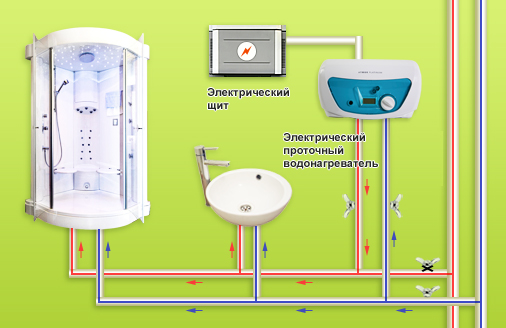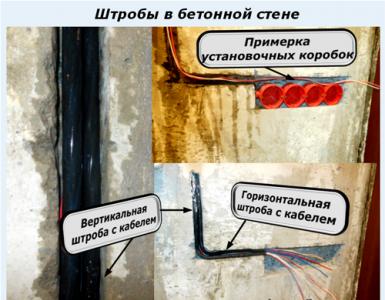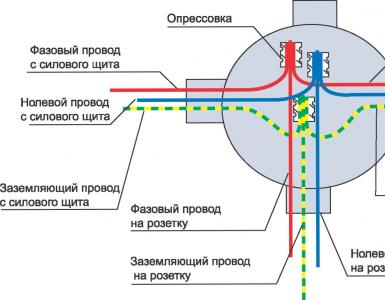How to connect a water heater
1. Select and measure as precisely as possible the place where you plan to install the water heater.
2. Determine how many taps the water heater will operate on (sink in the bathroom, sink in the kitchen, shower room, etc.) - this directly affects the choice of power and the connection process.
3. Be sure to find out the possibilities of wiring your apartment - the cross section and material of the cable, the maximum permissible load. If you do not know how to do this yourself, consult an electrician. This is especially important if you have chosen an instantaneous water heater. It must be understood that if the capabilities of the existing electrical wiring are insufficient, you will need to lay a new separate cable from the electrical panel in order for the connection to be safe. An important fact is the grounding of the device.
|
Calculation of the cross section of an electrical cable for connecting electrical appliances. Connecting high-power household appliances necessarily requires laying a separate electrical cable from the switchboard. Remember! If you try to connect a powerful instantaneous water heater to a washing machine outlet or to an outlet that is plugged into an electric stove, you run the risk of burnt wiring, which in turn can lead to a fire. Attention: if instead of copper you take an aluminum wire, you must apply an increasing factor equal to 1.3-1.5. |
4. If your tap water is not of good quality, it is highly recommended to install filters to purify the water before entering the water heater. Otherwise, the "life" of the water heater will be significantly less than declared by the manufacturer.
5. Determine for yourself the type of water heater (storage or instantaneous), select the design (round, rectangular, flat, etc.), and also determine the performance. See advice How to choose a water heater.
6. Depending on the installation location of the storage water heater, determine whether you need a wall or floor, vertical or horizontal water heater.
7. If you plan to install the appliance yourself, you will need to purchase additional materials (electrical wire, electrical circuit breaker, water supply, faucets, etc.).
In any case, the installation of a specific storage or instantaneous water heater must be carried out strictly in accordance with the instructions attached to the device. It describes the required number of holes on the wall, the number and features of fasteners, the sequence of connecting hoses, their size and location (vertically, horizontally), as well as other important information.
8. The storage water heater must be especially firmly fixed on hooks (bolts), without the possibility of moving to the sides.
9. All water heater connections to the water supply must be tight.
10. The water connection can be made with a plastic, metal-plastic, steel or copper pipe. It is not recommended to use flexible hoses with rubber hoses due to their rapid wear.
11. When turning on the instantaneous water heater, make sure that there is water in the water supply. When turning on the storage water heater, you need to make sure that the tank is full.
2 Electric storage water heater and its installation
1. It is necessary to think over in advance and measure the installation location of the water heater with the utmost accuracy.
2. In the conditions of small apartments and bathrooms, water heaters are most often installed in sanitary cabinets, kitchen niches, sometimes they are hung from the ceiling in a horizontal position. If there is very little space in the apartment for installing a water heater, you can choose a model with a reduced diameter or a flat design.
3. In most cases, water heaters up to 200 liters are wall-mounted, above 200 liters - floor-mounted.
4. Wall-mounted water heaters with a volume of more than 50 liters are recommended to be installed on a load-bearing wall. The device is suspended from the housing bracket on anchor bolts (hooks) fixed in the wall (not included in the delivery set). For installation of vertical models (30-100 liters) two hooks are used. The distance between the hooks must be 180 mm. Horizontal models (50 - 200 liters) are mounted on four hooks using the loops in the EWH brackets. To maintain EWH, the distance from the protective cover to the nearest surface in the direction of the removable flange axis must be at least:
- 30 centimeters - for models 5-80 liters;
- 50 centimeters - for models of 100-200 liters.
Horizontal water heaters, as a rule, have a volume of no more than 150 liters.
It is impossible to install a vertical water heater in a horizontal position!
5. Very often, storage water heaters are installed in a niche or a sanitary cabinet, and therefore access to the device can be difficult. In this case, you should think about the quality of the water heater in order to spend a minimum of effort on maintenance in the future and avoid repairing a hard-to-reach device.
Attention!
Do not forget about the installation of a safety valve - a device designed to protect equipment (water heater) and pipelines from mechanical destruction by excessive pressure. The safety valve performs its function by releasing excess water from the system at an overpressure. The valve also ensures that water is not discharged when the operating pressure is restored.
When installing the water heater in rooms that do not have waterproofing of floors and drainage channels, it is necessary to install a protective tray under the appliance with drainage into the sewer and connect the drain pipe to the drain hole of the safety valve.
The drain tube and the protective tray are usually not included in the scope of supply and are selected by the consumer independently.
Water connection
Attention!
If the water supplied to the water heater does not meet the standard for tap water, a filter must be installed at the inlet to the water heater, the type and parameters of which can be selected by the service technician.
Screw the safety valve onto the cold water inlet, marked in blue, by 3.5-4 turns, ensuring the tightness of the connection with any waterproofing material (flax, FUM tape, etc.). Connection to the water supply system is made only with the help of a special flexible plumbing, as well as flexible plastic or copper pipes. During installation, excessive efforts are not allowed on the water heater pipes in order to avoid damage to the pipes and the porcelain coating of the inner tank. After connecting, open the cold water supply valve to the water heater and the hot water tap on the mixer. When the appliance is completely filled, water will flow from the tap of the mixer in a continuous stream. When connecting the water heater in places not supplied with water, you can supply water to the water heater from an auxiliary tank, placing it at a height of at least 5 meters from the top of the device.
3 Electric instantaneous water heater and its installation

1. The first thing to pay attention to when connecting an instantaneous water heater is electrical wiring. It is recommended that even before buying the device, find out the maximum load of the electrical network in the apartment and, if necessary, install an additional machine on the electrical panel, run a separate wire through it and provide grounding. More information about choosing a cable was written at the beginning of this tip.
2. The performance of an instantaneous water heater directly depends on its power.
|
Power and performance of instantaneous water heaters First of all, you need to determine how much hot water you need. Water consumption in a family of 2 adults will be significantly lower than in a family with small children, and water consumption in a city apartment is much less than in a large country house. It is necessary to take into account the individual characteristics and habits of users. Contact sales consultants if you find it difficult to independently calculate. Capacity of instantaneous water heaters at outlet water temperature of 38°C, liters per minute:
Capacity of instantaneous water heaters at outlet water temperature of 55°C, liters per minute:
|
Attention!
- It is strictly not recommended to replace any components that are part of the instantaneous water heater. By replacing, for example, a hose with a watering can in the device, you will violate the throughput of the water heater, for which it is designed. For this reason, the water will not heat up properly.
- In no case should the outlet water be shut off to prevent it from boiling inside the appliance.
- When planning the purchase of an instantaneous water heater, it should be taken into account that it is able to raise the water temperature by about 20 degrees. Those. if you want to supply very cold (for example, spring) water to the device, then you will not be able to get hot water at the outlet - it will only be warm.













